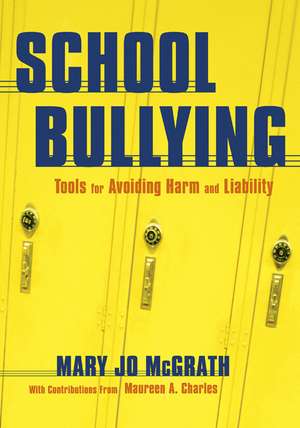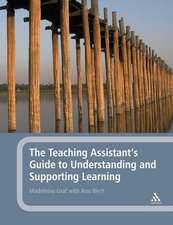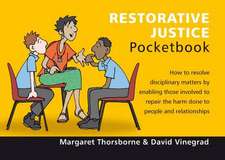School Bullying: Tools for Avoiding Harm and Liability
Autor Mary Jo McGrathen Limba Engleză Paperback – 25 sep 2006
Every hour of every day, students experience bullying and harassment at school by their peers. The immediate and long-term impact on the victims' learning capabilities, emotional health, and self-esteem is staggering. School Bullying: Tools for Avoiding Harm and Liability tackles this critical problem with an easy-to-use framework that guides educators in using constructive thinking, listening, and speaking to take effective action.
The McGrath SUCCEED® System outlined in this excellent text offers school leaders tools to create lasting, legally based, and ethically sound approaches to dealing with, and preventing, bullying in schools. It provides step-by-step procedures and practical tools for investigating bullying situations and communicating effectively with students, parents, teachers, staff, and the community.
| Toate formatele și edițiile | Preț | Express |
|---|---|---|
| Paperback (1) | 295.86 lei 6-8 săpt. | |
| SAGE Publications – 25 sep 2006 | 295.86 lei 6-8 săpt. | |
| Hardback (1) | 477.51 lei 6-8 săpt. | |
| SAGE Publications – 16 oct 2006 | 477.51 lei 6-8 săpt. |
Preț: 295.86 lei
Nou
Puncte Express: 444
Preț estimativ în valută:
56.61€ • 59.26$ • 47.12£
56.61€ • 59.26$ • 47.12£
Carte tipărită la comandă
Livrare economică 31 martie-14 aprilie
Preluare comenzi: 021 569.72.76
Specificații
ISBN-13: 9781412915724
ISBN-10: 1412915724
Pagini: 248
Dimensiuni: 178 x 254 x 13 mm
Greutate: 0.44 kg
Ediția:1
Editura: SAGE Publications
Colecția Corwin
Locul publicării:Thousand Oaks, United States
ISBN-10: 1412915724
Pagini: 248
Dimensiuni: 178 x 254 x 13 mm
Greutate: 0.44 kg
Ediția:1
Editura: SAGE Publications
Colecția Corwin
Locul publicării:Thousand Oaks, United States
Recenzii
"There are many books and state/federal publications on bullying; however, the integration of legal mandates and guidelines with direct application is quite rare. I think this text offers a valuable and unique cross-discipline resource with its thorough review of legislative precedents."
"Educators rarely receive this kind of detailed legal information in their graduate school studies. When people purchase this book, it will be like having their own lawyer sitting right next to them."
"Educators rarely receive this kind of detailed legal information in their graduate school studies. When people purchase this book, it will be like having their own lawyer sitting right next to them."
Cuprins
Preface
About the Author
Part I: FACT, MYTH AND IMPACT
1. What Bullying Is and What it Is Not
Spotting the Bully
How Bullies Act
Intent to Harm
An Imbalance of Power
The Perpetrator Enjoys Bullying
Repeated, Systematic Behavior
Bullying Hurts
Three Types of Bullying
Piercing the Myths About Bullies and Bullying
Myth #1: Our School Doesn’t Have Bullies
Myth #2: Other Safety Issues are a Bigger Concern for Kids
Myth #3: Schools Should Not Encourage Complaints
Myth #4: Teachers See Everything and Respond When Bullying Takes Place
Myth #5: It’s the Outcasts Who Bully Others
Myth #6: Bullies Appear Tough, but They Are All Actually Anxious and Insecure
Myth #7: The “Class Bully” Is Easy to Identify
Myth #8: It Is Impossible to Catch the Early Warning Signs
Myth #9: There Is No Correlation Between Bullying and Cases of Extreme Violence
Myth #10: Bullying Is Not a Legal Issue, It’s a Character Issue
Summary
2. Through the Eyes of the Victim
The Impact of Bullying on Victims
Impacted for Life
The Effects of Chronic Trauma
Post-Traumatic Stress
Blaming the Victim
Signs and Symptoms That May Indicate a Child Is Being Bullied
Six Powerful Practices for Detecting Bullying and Harassment in Schools
Safe, Responsive Adults Are the Key
Being a Safe Adult
Being a Responsive Adult
Getting Everyone Involved
The Nature and Scope of Anti-Bullying Interventions
But Is It Legally Fit?
Legal Avenues for Effecting Change
Summary
3. Social Scheming and TechnoBullying
Mean Girls
What Does Relational Bullying Look Like?
What’s the Harm?
The Marvels of Modern Technology
Three-Way Calling Attacks
Instant Messaging
Blogging
No Privacy on the Internet
Online Impersonation
What Can Schools Do?
Why Kids Don’t Report
The Code
Changing the Adult Response
The Complex Role of the Bystander
Group Dynamics
The Role of the Defender
Shifting the Dynamic: Training Bystanders
“I’m Afraid to Walk in That Corridor”
Is Your Discipline Code Adequate?
What Does Retaliation Look Like?
Handling Graffiti
Summary
Part II: THE LEGAL CONTEXT OF BULLYING
4. Bullying Through a Legal Lens
In Loco Parentis
Three Bodies of Law
What Is a Civil Action?
What Is Criminal Law?
What Is Administrative Law?
What Is Liability?
What Is Governmental Immunity?
What Is Negligence?
Where Does Negligence Fit Under the Law?
What Is a Duty of Care?
What Is the Standard of Care in Civil Actions for Negligence?
Under What Conditions May an Individual Be Found Individually Liable?
What Qualifies As “Notice”?
How Does a School Receive Notice?
What Are Deliberate Indifference and Reckless Disregard?
What Is Discrimination?
What Is the Difference Between Bias, Prejudice, and Discrimination?
What About Students’ First Amendment Rights?
The First Amendment and Retaliation: A Case in Point
Responsibility for the Behavior of Third Parties
Who Is Considered a Third Party?
Public School Students in Employment Settings
Enactment of State Law
Summary
5. When Bullying Is Legally Actionable
The Criterion: Point by Point
Point 1: Is a Protected Classification Involved or Is There Intent to Harm?
Point 2: Is the Behavior Unwelcome or Unwanted?
Point 3: Is the Behavior Severe or Persistent or Pervasive?
Point 4: Does the Behavior Substantially Interfere With the Student's Education?
Point 5: Does the Behavior Meet Both Subjective and Objective Tests Related to Its Level of Interference With Student Education?
Quid Pro Quo Sexual Harassment: An Exception to the Five-Point Criterion
In Review
Follow Your Policy
Bullying Policy Highlights
A Cautionary Note: The Importance of Being Strategic
Your Duty to Provide a Save Environment: The Courts Are Speaking
Established Guidelines for Protecting Students
Four Responsibilities Under the Duty to Provide a Safe Learning Environment
Covering All the Bases
Summary
PART III: LEGALLY SOUND AND PRINCIPLED-BASED ACTION
6. Daily Practices to Conquer Bullying
And the Complaints Keep Coming…
Power Tools That Build a Positive School Culture
A Legally Sound Response
Bullying: Three Levels of Response
Level I Response: Training the Front Line
Level I Response: Documentation
Level II Response
Level III Response
The McGrath SUCCEED System
The McGrath FICA Standard: The Basic Tool
How to Evaluate Facts and Make Decisions
The McGrath FICA Standard
The FACTS: What Happened?
IMPACT: The Harm of What Happened
When Facts and Impact Do Not Correlate
CONTEXT: The Other Factors Surrounding the Situation
Context: The Supreme Court Speaks
Miss Jones Interviews Becky
ACTION: Taking the Logical Next Step
Spiraling Forward
Back to Mr. Pogue
McGrath FICA in Review
Implementing the FICA Chat Infrastructure
Summary
7. Powered By Principles
The "Be" and the "Do" of Conquering Bullying
Why Trust, Respect, Understanding, and Growth?
Facts With Trust
Impact With Respect
Context With Understanding
Action With Growth
Four Lenses: Structure, Quality, Tone, and Balance
Structure Counts
Quality: Be Specific and Factual
Tone: The Relationship Factor
Balance: Working the FICA Formula With Integrity
It’s All About Relationship
The McGrath SUCCEED Levels of Mastery
A Transformational Approach
The Heart of the Matter
What It Takes To Be a Partner
Turning the Mirror Inward
The McGrath SUCCEED System as a Guide for Self-Reflection
The Internal “Imposter”
The Personal Awareness Paradox
The Questing Person
Being a Partner: Shared Vision
The Sociopath Next Door: A Notable Exception
No Matter How Mean the Streets
You Can SUCCEED
Lead With Your Heart
Summary
8. A Legally Sound "To Do" List
The Content of Bullying Through the Legal Lens
Initial Intake of Complaints: Preliminary Steps
The Role of the Complaint Manager
Processing Incident Reports From Third Parties
If the Complainant Cannot Read and/or Write English Proficiently
Complaint Intake With Very Young Students
Informing the Parents
Should You Audiotape the Child’s Answers?
Completing the Conversation With the Complainant
Don’t Be Afraid of Documentation
Deciding Who Investigates
Handing Off a Complaint to an Investigator
First Things First: Eight Preliminary Considerations
1. Take Action on the Complaint Within 24 Hours
2. If Sexual Harassment is Suspected, Use Two Investigators
3. Create a Confidential File
4. Conduct Interviews in a Private Room
5. Review All Pertinent Records
6. Review and Follow All Aplicable Policies, Rules, and Regulations
7. Talk to the Teachers With Whom the Parties Attend Classes
8. Do Not Limit the Investigation to Interviews of the Complainant and Alleged Perpetrator
Informal Versus Formal Resolution
A Working Definition of “Informal”
“Talking It Out”
Anonymity
Informal Does Not Mean Unwritten
What Is an Inquiry?
An Example of a Level II Matter
When Is Informal Resolution Clearly Inappropriate?
Innocent Until Proven Guilty
But I Know the Kid Is Guilty
Summary
9. Creating and Following a Game Plan: Level III Investigation
Know the “Players”
The Complaint Manager’s Role
The Response Team’s Role
Traits of an Investigator
The Title IX Coordinator
The Role of Counsel
Include All Players in the Game Plan
The Five Phases of an Investigation
Phase One: Gather the Facts
Phase Two: Check for Records of Concern
Phase Three: Evaluate the Testimony and Evidence
Phase Four: Write the Report
Phase Five: Follow-Up Actions By School Officials
Corroborative Evidence
Hearsay Evidence
Creating a McGrath Case and Report Organizer to Guide the Investigation From Start to Finish
Organize the Case File
The McGrath Case Report Organizer
Synopsis
Facts
Impact
Context
Action
Summary
10. Conclusion
Part IV: RESOURCES
Resource A:Forms
McGrath Incident Report
Complaint of Alleged Bullying or Illegal Harassment
McGrath Investigation Checklist
McGrath Template III
Resource B:Laws and Policies
Law Case Digest: A Sampler
Model Bullying Policy
Sample State Anti-Bullying Legislation
Resource C:Suggested 360-Degree Anti-Bullying Training Plan
Resource D:Glossary
Resource E: Useful Web Sites
Bibliography
Index
About the Author
Part I: FACT, MYTH AND IMPACT
1. What Bullying Is and What it Is Not
Spotting the Bully
How Bullies Act
Intent to Harm
An Imbalance of Power
The Perpetrator Enjoys Bullying
Repeated, Systematic Behavior
Bullying Hurts
Three Types of Bullying
Piercing the Myths About Bullies and Bullying
Myth #1: Our School Doesn’t Have Bullies
Myth #2: Other Safety Issues are a Bigger Concern for Kids
Myth #3: Schools Should Not Encourage Complaints
Myth #4: Teachers See Everything and Respond When Bullying Takes Place
Myth #5: It’s the Outcasts Who Bully Others
Myth #6: Bullies Appear Tough, but They Are All Actually Anxious and Insecure
Myth #7: The “Class Bully” Is Easy to Identify
Myth #8: It Is Impossible to Catch the Early Warning Signs
Myth #9: There Is No Correlation Between Bullying and Cases of Extreme Violence
Myth #10: Bullying Is Not a Legal Issue, It’s a Character Issue
Summary
2. Through the Eyes of the Victim
The Impact of Bullying on Victims
Impacted for Life
The Effects of Chronic Trauma
Post-Traumatic Stress
Blaming the Victim
Signs and Symptoms That May Indicate a Child Is Being Bullied
Six Powerful Practices for Detecting Bullying and Harassment in Schools
Safe, Responsive Adults Are the Key
Being a Safe Adult
Being a Responsive Adult
Getting Everyone Involved
The Nature and Scope of Anti-Bullying Interventions
But Is It Legally Fit?
Legal Avenues for Effecting Change
Summary
3. Social Scheming and TechnoBullying
Mean Girls
What Does Relational Bullying Look Like?
What’s the Harm?
The Marvels of Modern Technology
Three-Way Calling Attacks
Instant Messaging
Blogging
No Privacy on the Internet
Online Impersonation
What Can Schools Do?
Why Kids Don’t Report
The Code
Changing the Adult Response
The Complex Role of the Bystander
Group Dynamics
The Role of the Defender
Shifting the Dynamic: Training Bystanders
“I’m Afraid to Walk in That Corridor”
Is Your Discipline Code Adequate?
What Does Retaliation Look Like?
Handling Graffiti
Summary
Part II: THE LEGAL CONTEXT OF BULLYING
4. Bullying Through a Legal Lens
In Loco Parentis
Three Bodies of Law
What Is a Civil Action?
What Is Criminal Law?
What Is Administrative Law?
What Is Liability?
What Is Governmental Immunity?
What Is Negligence?
Where Does Negligence Fit Under the Law?
What Is a Duty of Care?
What Is the Standard of Care in Civil Actions for Negligence?
Under What Conditions May an Individual Be Found Individually Liable?
What Qualifies As “Notice”?
How Does a School Receive Notice?
What Are Deliberate Indifference and Reckless Disregard?
What Is Discrimination?
What Is the Difference Between Bias, Prejudice, and Discrimination?
What About Students’ First Amendment Rights?
The First Amendment and Retaliation: A Case in Point
Responsibility for the Behavior of Third Parties
Who Is Considered a Third Party?
Public School Students in Employment Settings
Enactment of State Law
Summary
5. When Bullying Is Legally Actionable
The Criterion: Point by Point
Point 1: Is a Protected Classification Involved or Is There Intent to Harm?
Point 2: Is the Behavior Unwelcome or Unwanted?
Point 3: Is the Behavior Severe or Persistent or Pervasive?
Point 4: Does the Behavior Substantially Interfere With the Student's Education?
Point 5: Does the Behavior Meet Both Subjective and Objective Tests Related to Its Level of Interference With Student Education?
Quid Pro Quo Sexual Harassment: An Exception to the Five-Point Criterion
In Review
Follow Your Policy
Bullying Policy Highlights
A Cautionary Note: The Importance of Being Strategic
Your Duty to Provide a Save Environment: The Courts Are Speaking
Established Guidelines for Protecting Students
Four Responsibilities Under the Duty to Provide a Safe Learning Environment
Covering All the Bases
Summary
PART III: LEGALLY SOUND AND PRINCIPLED-BASED ACTION
6. Daily Practices to Conquer Bullying
And the Complaints Keep Coming…
Power Tools That Build a Positive School Culture
A Legally Sound Response
Bullying: Three Levels of Response
Level I Response: Training the Front Line
Level I Response: Documentation
Level II Response
Level III Response
The McGrath SUCCEED System
The McGrath FICA Standard: The Basic Tool
How to Evaluate Facts and Make Decisions
The McGrath FICA Standard
The FACTS: What Happened?
IMPACT: The Harm of What Happened
When Facts and Impact Do Not Correlate
CONTEXT: The Other Factors Surrounding the Situation
Context: The Supreme Court Speaks
Miss Jones Interviews Becky
ACTION: Taking the Logical Next Step
Spiraling Forward
Back to Mr. Pogue
McGrath FICA in Review
Implementing the FICA Chat Infrastructure
Summary
7. Powered By Principles
The "Be" and the "Do" of Conquering Bullying
Why Trust, Respect, Understanding, and Growth?
Facts With Trust
Impact With Respect
Context With Understanding
Action With Growth
Four Lenses: Structure, Quality, Tone, and Balance
Structure Counts
Quality: Be Specific and Factual
Tone: The Relationship Factor
Balance: Working the FICA Formula With Integrity
It’s All About Relationship
The McGrath SUCCEED Levels of Mastery
A Transformational Approach
The Heart of the Matter
What It Takes To Be a Partner
Turning the Mirror Inward
The McGrath SUCCEED System as a Guide for Self-Reflection
The Internal “Imposter”
The Personal Awareness Paradox
The Questing Person
Being a Partner: Shared Vision
The Sociopath Next Door: A Notable Exception
No Matter How Mean the Streets
You Can SUCCEED
Lead With Your Heart
Summary
8. A Legally Sound "To Do" List
The Content of Bullying Through the Legal Lens
Initial Intake of Complaints: Preliminary Steps
The Role of the Complaint Manager
Processing Incident Reports From Third Parties
If the Complainant Cannot Read and/or Write English Proficiently
Complaint Intake With Very Young Students
Informing the Parents
Should You Audiotape the Child’s Answers?
Completing the Conversation With the Complainant
Don’t Be Afraid of Documentation
Deciding Who Investigates
Handing Off a Complaint to an Investigator
First Things First: Eight Preliminary Considerations
1. Take Action on the Complaint Within 24 Hours
2. If Sexual Harassment is Suspected, Use Two Investigators
3. Create a Confidential File
4. Conduct Interviews in a Private Room
5. Review All Pertinent Records
6. Review and Follow All Aplicable Policies, Rules, and Regulations
7. Talk to the Teachers With Whom the Parties Attend Classes
8. Do Not Limit the Investigation to Interviews of the Complainant and Alleged Perpetrator
Informal Versus Formal Resolution
A Working Definition of “Informal”
“Talking It Out”
Anonymity
Informal Does Not Mean Unwritten
What Is an Inquiry?
An Example of a Level II Matter
When Is Informal Resolution Clearly Inappropriate?
Innocent Until Proven Guilty
But I Know the Kid Is Guilty
Summary
9. Creating and Following a Game Plan: Level III Investigation
Know the “Players”
The Complaint Manager’s Role
The Response Team’s Role
Traits of an Investigator
The Title IX Coordinator
The Role of Counsel
Include All Players in the Game Plan
The Five Phases of an Investigation
Phase One: Gather the Facts
Phase Two: Check for Records of Concern
Phase Three: Evaluate the Testimony and Evidence
Phase Four: Write the Report
Phase Five: Follow-Up Actions By School Officials
Corroborative Evidence
Hearsay Evidence
Creating a McGrath Case and Report Organizer to Guide the Investigation From Start to Finish
Organize the Case File
The McGrath Case Report Organizer
Synopsis
Facts
Impact
Context
Action
Summary
10. Conclusion
Part IV: RESOURCES
Resource A:Forms
McGrath Incident Report
Complaint of Alleged Bullying or Illegal Harassment
McGrath Investigation Checklist
McGrath Template III
Resource B:Laws and Policies
Law Case Digest: A Sampler
Model Bullying Policy
Sample State Anti-Bullying Legislation
Resource C:Suggested 360-Degree Anti-Bullying Training Plan
Resource D:Glossary
Resource E: Useful Web Sites
Bibliography
Index
Descriere
The author offers leaders practical tools and strategies to create legally based and ethically sound approaches to dealing with and preventing bullying in schools.














